|
Wales
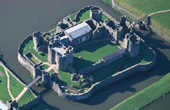
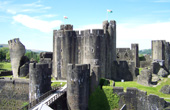 Our first significant stop in Wales was Caerphilly Castle, the greatest castle I've ever seen and one of the largest in all of Europe. It's in a concentric design and surrounded by artificial lakes to the north and south, a fortified wall to the east, and a stone revetment to the west. An aerial photo at left (which I did not take) offers some sense of its size and complexity. One notable characteristic is a leaning tower, allegedly caused by Parliamentarian gunpowder. More of our pictures are at right and below.
Our first significant stop in Wales was Caerphilly Castle, the greatest castle I've ever seen and one of the largest in all of Europe. It's in a concentric design and surrounded by artificial lakes to the north and south, a fortified wall to the east, and a stone revetment to the west. An aerial photo at left (which I did not take) offers some sense of its size and complexity. One notable characteristic is a leaning tower, allegedly caused by Parliamentarian gunpowder. More of our pictures are at right and below.
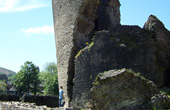

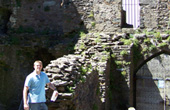



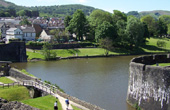

 After Caerphilly we set out on a long drive north through narrow, rural Welsh roads. The landscape and countryside was beautiful. Gently rolling hills and centuries-old rock fences were around each corner. The houses and buildings were wonderfully quaint, too. For me, Wales carries a certain charm and magic that really reveals itself in drives like this. A striking example of this came through in a small old cemetary sitting near a serene creek. Naturally, we got out to take in its mystique.
After Caerphilly we set out on a long drive north through narrow, rural Welsh roads. The landscape and countryside was beautiful. Gently rolling hills and centuries-old rock fences were around each corner. The houses and buildings were wonderfully quaint, too. For me, Wales carries a certain charm and magic that really reveals itself in drives like this. A striking example of this came through in a small old cemetary sitting near a serene creek. Naturally, we got out to take in its mystique.






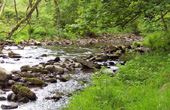
Eventually we arrived in Penmachno, a tiny Welsh town of roughly 600 residents. The community is situated in a valley within the gorgeous Snowdonia National Park. Visiting small towns off the beaten path is, in my mind, the best way to travel, and Penmachno did not disappoint. We stayed at a cozy bunkhouse called the Eagles, the site of an inn since the 1600s. The Eagles had a well stocked bar and there, over refreshing glasses of beer, we had a chance to chat with incredibly kind and interesting locals. Of particular note was Pat (wearing a grey fleece in the third photo below), an Irishman who had settled in Penmachno some time ago. Pat was kind, funny and intelligent. He had even returned to college while in semi-retirement.


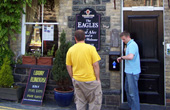

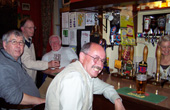


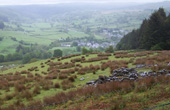
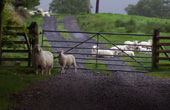 During our long drive that day I had fallen in love with the Welsh hills and really wanted to climb one. So when I brought up the subject with Pat, he surprisingly offered to get up at 6 a.m. and hike with us up a nearby hill called Pen-y-bryn, which means "top of the hill." Getting to hike this met my expectations, and getting to do it with Pat made it even nicer. We continued to learn more about local culture from him and got to see great views of Penmachno in the valley below.
During our long drive that day I had fallen in love with the Welsh hills and really wanted to climb one. So when I brought up the subject with Pat, he surprisingly offered to get up at 6 a.m. and hike with us up a nearby hill called Pen-y-bryn, which means "top of the hill." Getting to hike this met my expectations, and getting to do it with Pat made it even nicer. We continued to learn more about local culture from him and got to see great views of Penmachno in the valley below.
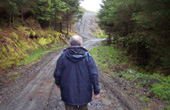

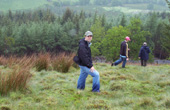



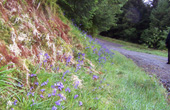
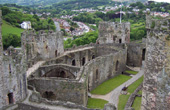
 Following the hill hike we set out on a day of hopping between an "iron ring" of castles built by Edward I in northern Wales. First up was Conwy Castle, a gritty fortress overlooking the entrance to the River Conwy (pictured left, right and below). Although Conwy itself is a classic walled town, the castle relies more on natural defenses like a rock outcrop and the fluctuation of the neighboring sea. When we paused to eat lunch in the town, the castle seemed to loom over it, its presence not forgotten.
Following the hill hike we set out on a day of hopping between an "iron ring" of castles built by Edward I in northern Wales. First up was Conwy Castle, a gritty fortress overlooking the entrance to the River Conwy (pictured left, right and below). Although Conwy itself is a classic walled town, the castle relies more on natural defenses like a rock outcrop and the fluctuation of the neighboring sea. When we paused to eat lunch in the town, the castle seemed to loom over it, its presence not forgotten.
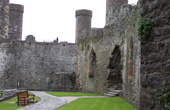

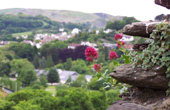

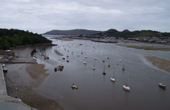

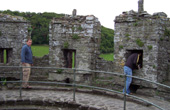
Our next castle visit was Beaumaris, pictured below. Although this castle is considered the most architecturally perfect in Britain, I found it to be relatively plain and square. The building was not completed because finances ran out when Edward turned his attention towards Scotland, and this no doubt detracted from its grandeur. However, the inner ward is impressive for its size (3/4 of an acre), and standing atop the towers one gets beautiful views of the nearby sea and mountains.
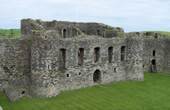

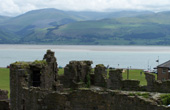

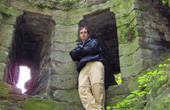


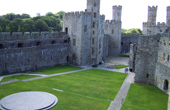
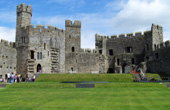 Our final stop that day, and indeed our last Welsh castle visit of the trip, was Caernarfon, pictured left, right and below. This castle is arguably known most for its ceremonial history. In 1301 King Edward I invested his son with the title of "Prince of Wales" here. In 1911 the castle was again used for the investiture of the then Prince of Wales, the future Edward VIII. Most recently was the investiture of Charles, Prince of Wales, in 1969. Caernarfon had a certain simple elegance befitting its history.
Our final stop that day, and indeed our last Welsh castle visit of the trip, was Caernarfon, pictured left, right and below. This castle is arguably known most for its ceremonial history. In 1301 King Edward I invested his son with the title of "Prince of Wales" here. In 1911 the castle was again used for the investiture of the then Prince of Wales, the future Edward VIII. Most recently was the investiture of Charles, Prince of Wales, in 1969. Caernarfon had a certain simple elegance befitting its history.


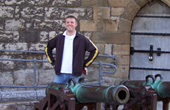



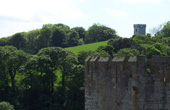

 As evening approached we decided to start making our way back toward London. Along the way we stopped in a town called Llangollen. An old mill on the River Dee had been converted into a restaurant, and there we decided to have supper (pictured left and right). We made it back to England that night, staying in Shrewsbury, and then pushed on to Oxford the next day (pictured below). Of course, Oxford is in England, not Wales, but I include it here to maintain chronological integrity.
As evening approached we decided to start making our way back toward London. Along the way we stopped in a town called Llangollen. An old mill on the River Dee had been converted into a restaurant, and there we decided to have supper (pictured left and right). We made it back to England that night, staying in Shrewsbury, and then pushed on to Oxford the next day (pictured below). Of course, Oxford is in England, not Wales, but I include it here to maintain chronological integrity.







Oxford was an interesting mix of historic academia and mass tourism, not unlike Harvard. It offered a hint of city life that I had begun yearning for after a long tour of rural Wales. We geared our trip toward experiencing a wide variety of Britain, and Wales was a wonderful place to absorb that quaint mystique only rural areas can offer. But now it was time to jump into London. Click here for more on that.
|